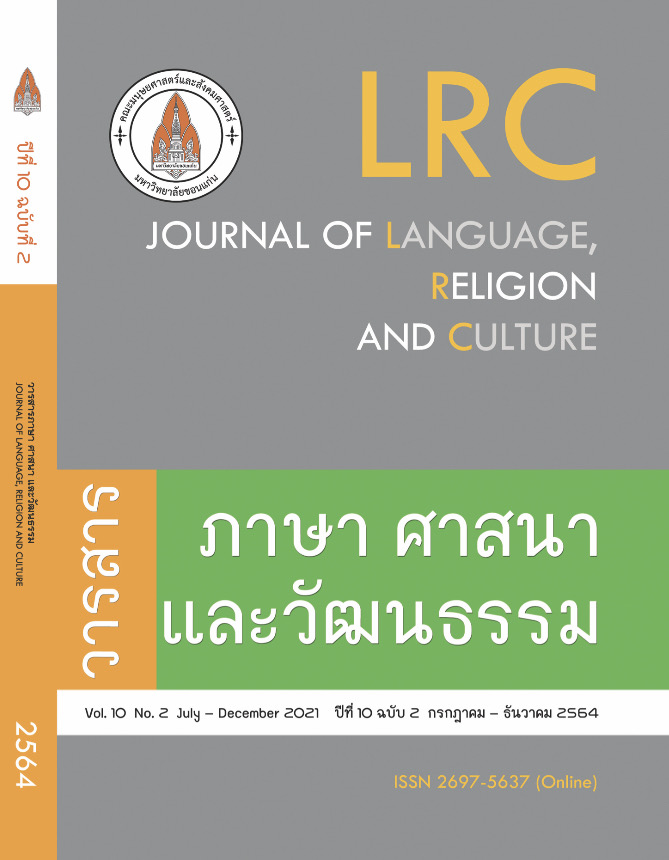การแปลบุพบทวลีที่มี “in” เป็นหน่วยคำหลัก
การแปลบุพบทวลีที่มี “in” เป็นหน่วยคำหลัก
คำสำคัญ:
บุพบทวลี, กลวิธีการแปล, การแปลนวนิยาย, ไวยากรณ์ปริวรรต, ภาษาศาสตร์ปริชานบทคัดย่อ
เมื่อคำบุพบท “in” ไม่ได้แปลว่า “ใน” เสมอไป อะไรคือปัจจัยสำคัญที่นักแปลต้องคำนึงถึง บทความวิจัยนี้ศึกษากลวิธีการแปลบุพบทวลีที่มี “in” เป็นหน่วยคำหลัก เพื่อวิเคราะห์ความสัมพันธ์ของโครงสร้างบุพบทวลีกับกลวิธีการแปลงานวรรณกรรมนวนิยายที่ผู้แปลเลือกใช้เพื่อรักษาความเท่าเทียมกันระหว่างภาษาต้นทางและปลายทางในแง่โครงสร้าง ความหมาย และความงดงามทางภาษา โดยการวิเคราะห์โครงสร้างบุพบทวลีด้วยหลักไวยากรณ์ปริวรรตผ่านมุมมองด้านภาษาศาสตร์ปริชาน รวมถึงจำแนกกลวิธีการแปลด้วยวิธีการเปรียบต่างระหว่างต้นฉบับคือนวนิยายของ Toni Morrison เรื่อง The Bluest Eye และบทแปล “ดวงตาสีฟ้าสุดฟ้า” โดยจุฑามาศ แอนเนียน ผลการวิจัยชี้ให้เห็นว่าผู้แปลมีแนวโน้มถ่ายทอดบุพบทวลีโดยใช้โครงสร้างแบบเดียวกันกับต้นฉบับสูงถึงร้อยละ 76 แต่ในทางกลับกันผู้แปลเลือกถ่ายทอดความหมายด้วยกลวิธีการแปลตรงตัวเพียงร้อยละ 47 โดยมีปัจจัยสำคัญคือโครงสร้างบุพบทวลี ลักษณะทางภาษาศาสตร์ และลักษณะของตัวบทที่เป็นงานเขียนประเภทนวนิยาย
เอกสารอ้างอิง
จรัลวิไล จรูญโรจน์. (2555). ภาษาศาสตร์เบื้องต้น. (พิมพ์ครั้งที่ 5). กรุงเทพฯ: สำนักพิมพ์มหาวิทยาลัยเกษตรศาสตร์.
มอร์ริสัน, ที. (2563). ดวงตาสีฟ้าสุดฟ้า (จุฑามาศ แอนเนียน, ผู้แปล). กรุงเทพมหานคร: สำนักพิมพ์ไลบรารี่ เฮาส์.
ราชบัณทิตยสถาน. (2554). พจนานุกรมฉบับราชบัณฑิตยสถาน. พิมพ์ครั้งที่ 2. กรุงเทพมหานคร: ราชบัณฑิตยสถาน.
วิไลวรรณ อรุณมานะกุล. (2545). การใช้คำบุพบทในภาษาอังกฤษของนักศึกษาไทย: กรณีศึกษานักศึกษาชั้นปีที่ 1 โครงการนักวิจัยรุ่นใหม่. กรุงเทพมหานคร: มหาวิทยาลัยธรรมศาสตร์.
วิไลวรรณ อรุณมานะกุล. (2562). คำบุพบทแสดงพื้นที่ในสถานการณ์เกี่ยวกับการเคลื่อนที่: กรณีศึกษาภาษาอังกฤษและไทย. Thoughts, 2019(1), 27-47.
พุทธมนต์ กัญจนบุศย์. (2558).การแปลหนังสือและวิเคราะห์การแก้ปัญหาการแปลตามกลวิธีของโมนา เบเคอร์: กรณีศึกษาจากหนังสือเรื่อง “ทําอย่างไรจะปราศจากโรคและชะลอความชรา” ของ ศ.นพ. เฉก ธนะสิริ. (วิทยานิพนธ์ปริญญามหาบัณฑิต). มหาวิทยาลัยธรรมศาสตร์. คณะศิลปศาสตร์. สาขาวิชาการแปลภาษาอังกฤษและไทย.
เยาวลักษณ์ อภิชาติวัลลภ. (2520). การใช้คำบุพบทภาษาอังกฤษของนักศึกษาชั้นปีที่ 1 มหาวิทยาลัยขอนแก่น. (วิทยานิพนธ์ปริญญามหาบัณฑิต). จุฬาลงกรณ์มหาวิทยาลัย. คณะครุศาสตร์. สาขาวิชามัธยมศึกษา
สายใจ ลีลาน้อย. (2553). การวิเคราะห์หน้าที่บุพบทวลีที่มีหน่วยคำ “โดย” เป็นคำหลัก. สาขาวิชาภาษาศาสตร์การศึกษา. มหาวิทยาลัยศรีนครินทรวิโรฒ.
Baker, M. (2018). In Other Words: A Coursebook on Translation. 3rd ed. London: Routledge.
Bursky, Robert F. (1997). Noam Chomsky: A Life of Dissent. Cambridge: The MIT Press.
Cambridge University Press. (2020, June 2). Preposition. Retrieved from
https://dictionary.cambridge.org/dictionary/english/preposition
Catford, J. (1995) A linguistic Theory of Translation. London. Oxford University Press.
Chomsky, N. (1985). Aspects of the Theory of Syntax. Massachusetts: The M.I.T. Press.
Culler, J. (1976). Saussure, Glasgow: Fontana/Collins.
Frawley, W. (1984). Translation: literary, linguistic and philosophical perspectives. Delaware: University of Delaware Press.
French, F.G. (1972). The Bones of English. Teaching and Learning English. London: Longman Group Limited.
Ghazala, S.H. (2015). Literary Translation from a Stylistic Perspective. Studies in English Language Teaching, 3(2), 124-145. Retrieved from http://www.scholink.org/ojs/index .php/selt/article/view/297
Halverson, S. (2003). The cognitive basis of translation universals. Target International Journal of Translation Studies, 15(2), 197–241. doi: https://doi.org/10.1075/target.15.2.02hal
Hoey, M. & Houghton, D. (2001). Contrastive analysis and translation. In Baker, M. (ed.), Routledge encyclopedia of translation studies, 45-49. New York: Routledge.
Jacobs, R. A. & Rosenbaum, P. S. (1968). Transformational Grammar. Massachusetts: Blaisdell Publishing Company.
Lakoff, G. (1987). Cognitive Models and Prototype Theory. Chicago: University of Chicago Press.
Landers, C. (2001). Literary Translation: A Practical Guide. Clevedon: Multilingual Matters.
Larson, M.L. (1998). Meaning-Based Translation: A Guide to Cross Language Equivalence (2nd Edition). New York: University Press of America.
Levin, B. (1993). English Verb Classes and Alternations: A Preliminary Investigation. Chicago: The University of Chicago Press.
Linstromberg, Seth. (1998). English Prepositions Explained. Amsterdam: John Benjamins Publishing.
Morrison, T. (2019). The Bluest Eye. London: Penguin Random House.
Nida, E. A. & Taber, C. R. (1982). The theory and Practice of translation. Leiden: E. J. Brill.
O’Dowd, Elizabeth M. (1998). Prepositions and Particles in English. New York: Oxford University Press.
Oxford University Press. (2020, June 2). Definition of Preposition. Retrieved from https:// www.oxfordlearnersdictionaries.com/definition/english/preposition?q=preposition
Tyler, A. & Evan, V. (2003). The Semantics of English Preposition. New York: Cambridge University Press.
Vinay, J.P. and Darbelnet, J. (1995). Comparative Stylistics of French and English: A Methodology for Translation, Amsterdam: Benjamins.
Wales, K. (1989/2001). A Dictionary of Stylistics. London: Longman.







